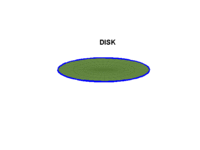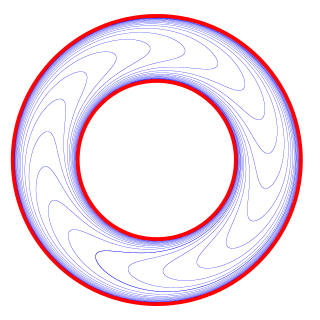In mathematics, more specifically in functional analysis, a Banach space is a complete normed vector space. Thus, a Banach space is a vector space with a metric that allows the computation of vector length and distance between vectors and is complete in the sense that a Cauchy sequence of vectors always converges to a well-defined limit that is within the space.

In mathematics, a normed vector space or normed space is a vector space over the real or complex numbers, on which a norm is defined. A norm is the formalization and the generalization to real vector spaces of the intuitive notion of "length" in the real (physical) world. A norm is a real-valued function defined on the vector space that is commonly denoted and has the following properties:
- It is nonnegative, meaning that for every vector
- It is positive on nonzero vectors, that is,
- For every vector and every scalar
- The triangle inequality holds; that is, for every vectors and
In topology and related branches of mathematics, Tychonoff spaces and completely regular spaces are kinds of topological spaces. These conditions are examples of separation axioms. A Tychonoff space refers to any completely regular space that is also a Hausdorff space; there exist completely regular spaces that are not Tychonoff.
This is a glossary of some terms used in the branch of mathematics known as topology. Although there is no absolute distinction between different areas of topology, the focus here is on general topology. The following definitions are also fundamental to algebraic topology, differential topology and geometric topology.

In mathematics, an open set is a generalization of an open interval in the real line.
In mathematics, particularly topology, one describes a manifold using an atlas. An atlas consists of individual charts that, roughly speaking, describe individual regions of the manifold. If the manifold is the surface of the Earth, then an atlas has its more common meaning. In general, the notion of atlas underlies the formal definition of a manifold and related structures such as vector bundles and other fiber bundles.
Distributions, also known as Schwartz distributions or generalized functions, are objects that generalize the classical notion of functions in mathematical analysis. Distributions make it possible to differentiate functions whose derivatives do not exist in the classical sense. In particular, any locally integrable function has a distributional derivative.
In mathematics, a base (or basis) for the topology τ of a topological space (X, τ) is a family of open subsets of X such that every open set of the topology is equal to the union of some sub-family of . For example, the set of all open intervals in the real number line is a basis for the Euclidean topology on because every open interval is an open set, and also every open subset of can be written as a union of some family of open intervals.

In mathematics, general topology is the branch of topology that deals with the basic set-theoretic definitions and constructions used in topology. It is the foundation of most other branches of topology, including differential topology, geometric topology, and algebraic topology. Another name for general topology is point-set topology.

In topology and related areas of mathematics, the quotient space of a topological space under a given equivalence relation is a new topological space constructed by endowing the quotient set of the original topological space with the quotient topology, that is, with the finest topology that makes continuous the canonical projection map. In other words, a subset of a quotient space is open if and only if its preimage under the canonical projection map is open in the original topological space.
In mathematics, and more particularly in set theory, a cover of a set is a family of subsets of whose union is all of . More formally, if is an indexed family of subsets , then is a cover of if . Thus the collection is a cover of if each element of belongs to at least one of the subsets .

In mathematics, a foliation is an equivalence relation on an n-manifold, the equivalence classes being connected, injectively immersed submanifolds, all of the same dimension p, modeled on the decomposition of the real coordinate space Rn into the cosets x + Rp of the standardly embedded subspace Rp. The equivalence classes are called the leaves of the foliation. If the manifold and/or the submanifolds are required to have a piecewise-linear, differentiable, or analytic structure then one defines piecewise-linear, differentiable, or analytic foliations, respectively. In the most important case of differentiable foliation of class Cr it is usually understood that r ≥ 1. The number p is called the dimension of the foliation and q = n − p is called its codimension.
In functional analysis and related areas of mathematics, locally convex topological vector spaces (LCTVS) or locally convex spaces are examples of topological vector spaces (TVS) that generalize normed spaces. They can be defined as topological vector spaces whose topology is generated by translations of balanced, absorbent, convex sets. Alternatively they can be defined as a vector space with a family of seminorms, and a topology can be defined in terms of that family. Although in general such spaces are not necessarily normable, the existence of a convex local base for the zero vector is strong enough for the Hahn–Banach theorem to hold, yielding a sufficiently rich theory of continuous linear functionals.
In topology, a topological space is called a compactly generated space or k-space if its topology is determined by compact spaces in a manner made precise below. There is in fact no commonly agreed upon definition for such spaces, as different authors use variations of the definition that are not exactly equivalent to each other. Also some authors include some separation axiom in the definition of one or both terms, and others don't.
In topology and related areas of mathematics, a subspace of a topological space X is a subset S of X which is equipped with a topology induced from that of X called the subspace topology.
In general topology and related areas of mathematics, the final topology on a set with respect to a family of functions from topological spaces into is the finest topology on that makes all those functions continuous.
In topology and related fields of mathematics, a sequential space is a topological space whose topology can be completely characterized by its convergent/divergent sequences. They can be thought of as spaces that satisfy a very weak axiom of countability, and all first-countable spaces are sequential.
In mathematics, a polyadic space is a topological space that is the image under a continuous function of a topological power of an Alexandroff one-point compactification of a discrete space.
In mathematics, the injective tensor product of two topological vector spaces (TVSs) was introduced by Alexander Grothendieck and was used by him to define nuclear spaces. An injective tensor product is in general not necessarily complete, so its completion is called the completed injective tensor products. Injective tensor products have applications outside of nuclear spaces. In particular, as described below, up to TVS-isomorphism, many TVSs that are defined for real or complex valued functions, for instance, the Schwartz space or the space of continuously differentiable functions, can be immediately extended to functions valued in a Hausdorff locally convex TVS without any need to extend definitions from real/complex-valued functions to -valued functions.
In mathematics, specifically in order theory and functional analysis, a locally convex vector lattice (LCVL) is a topological vector lattice that is also a locally convex space. LCVLs are important in the theory of topological vector lattices.


























































